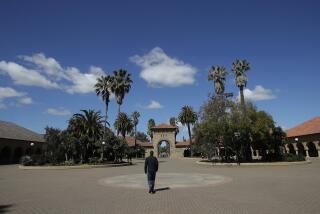Campus Correspondent : Squeezing the Middle Class Out of Private Universities
CHICAGO â As anyone who has experienced the college financial-aid system knows, âaffluentâ is a vague category. From the institutionâs point of view, affluent means being able to pay for an education. But not every family a private university deems affluent can annually sign over $19,000 for four years to cover its cost of full tuition.
There is a huge difference between a household whose middle- to high-income status is the result of two working parents and a wealthy family with savings and investments. Moreover, there is often a gap between what the school sees the family as able to contribute, and what it can without considerable sacrifice to the rest of the family.
My mother is a public-school nurse, my father an operations manager at a steel-processing plant. I have two younger sisters who are college-bound. My parents paid this yearâs tuition--about $18,600--in full. Next year, it will be $19,000-plus. Thatâs an enormous financial burden for a middle-class family.
College financial-aid brochures promise that the utmost care will be taken to evaluate and provide for a studentâs financial needs. Aid awards are determined individually, with a variety of factors taken into account. But attention to the specifics of a studentâs economic situation stops once it is decided that he or she has the means of paying tuition.
Students on the borderline of eligibility for need-based aid are the losers in this system. Loans compel them to take the first job that comes along after graduation so they can make their payments. A student who is ineligible for need-based aid may owe tens of thousands of dollars after financing a four-year education.
Even with loans, a student must often earn what the family cannot, or will not, pay. Having to work takes time away from a studentâs studies and free time to explore extracurricular activities.
Iâm responsible for paying for my room, board and personal expenses, including books, which amounts to about $6,000 an academic year. In addition to money from a student loan, I work 20-25 hours a week. I go to classes all morning, work all afternoon, do my schoolwork at night. I should be studying more, but am often too tired by the time I get home. I participate in no extracurricular activities.
A middle-class student who falls between affluent and needy is often directed to apply at a state institution with a less expensive tuition for residents of the state. But a student should not be forced to pursue this option simply because the financial-aid system caters to the extremes while claiming to provide equal opportunities for all.
According to one survey, of an average $19,110 tuition charged at 31 universities, 19.7% is allocated to subsidize need-based scholarships. The percentage is the same for the most affluent and for those who must borrow and work to pay for their education.
Private universities must begin to pay closer attention to the overall financial situations of middle-class students. Making the percentage of tuition channeled to need-based scholarships tax-deductible is one solution. A tax break would benefit middle-class parents, or at least make it more feasible for them to send their children to a prestigious institution.
Without such changes in the financial-aid system, the nationâs top universities may soon be accessible to only the richest and the poorest of students.






